Mule Deer Foundation Leads Idaho Migration Projects

Jessie is a home-grown Idahoan, who grew up working on…
Exploring the Idaho migration projects and the inspiration of a conservation leader.
My name is Jessie Shallow and I am a new partner biologist with the Mule Deer Foundation who works with the Idaho Fish and Game (IDFG) on Idaho migration projects. My roots began in Idaho growing up as a farm girl on a fifth-generation farm in the southeast part of the state. I earned my work ethic from the spud fields and learned to play and appreciate the wonders of Idaho in the nearby public lands. From fishing on the South Fork of the Snake to soaking up the thrills offered by skiing the black diamonds on the Wyoming border to white water rafting in central Idaho, I learned at an early age that I wanted to work outside in Idaho. At 18, I left the flat spud fields bound for the mountains in central Idaho to follow my dream of becoming a white-water rafting guide, and it was there that I heard you could jump out of a helicopter and catch wild deer and elk which led me to pursuing my dream job with IDFG.
Although new to MDF, I am not new to the organization or working on mule deer conservation. In 2012, with support from MDF and IDFG, I completed my master’s degree focused on mule deer habitat selection.
MDF not only helped funding the project but numerous volunteers even came to work 12-hour days, side-by side, with me and other biologists in the mosquito infested Caribou Mountains catching and collaring deer. Based on my study, we were able to compare what habitat characteristics mule deer choose in high quality habitat compared to the lower quality, drier, rugged habitats in central Idaho. No surprise, results showed that sagebrush and bitterbrush were the two most important plants to mule deer during summer. Not only do they use these shrubs as hiding cover for their fawns, but they are important forage in summer months. In winter, sagebrush is an essential food source and key to functioning winter ranges and survivability.

After 16 years with IDFG, I changed to my current position with MDF, which allows me to lead and coordinate efforts for big game habitats at a larger scale and increase effectiveness through better coordination with stakeholders. Recent emphasis from the Secretary of the Interior in promoting collaboration between states, conservation groups, and federal agencies to enhance and improve the quality habitats on big-game winter ranges and migration corridors through SO3362 (signed at the MDF Western Hunting & Conservation Expo in 2018) was the genesis for my position. My goal is to bring partners together on habitat projects and better leverage funding from multiple sources. Examples of conservation projects I am working on include—coordinating sagebrush planting projects in big game winter ranges damaged by fires, improving the effectiveness of wildlife highway crossing structures, prioritizing the conversion of fences to wildlife friendly designs, and landscape-level noxious weed and annual invasive grass treatments on winter range and sage grouse habitat.

This past year, 25 miles of fence were converted to wildlife friendly fence in Idaho in partnership with many stakeholders. In many instances, migratory big game herds had to navigate fences between summer to winter range, where sections of fence were acting as barriers. In the Crooked Drainage near Dubois, an important migration route for mule deer, elk, and pronghorn with some traveling as far as 100 miles back to their winter range, wire mesh fencing was removed and replaced with wildlife friendly barbed wire fence. By reducing the height from 50 to 42 inches, adding a smooth-wire bottom strand at 16 inches height, and having at least 12 inches between the top two wires animals can now more easily cross where needed without the fence acting as a barrier to movement. Projects like the Crooked Creek fence conversion are hugely beneficial to migratory herds, especially considering how many obstacles they must navigate through or around, by making their entire seasonal habitat needs available without barriers. The project could not have been completed without partnerships and cooperation and, through my position at MDF, I was able to help MDF fund the project with a grant from Bass Pro Shops and Cabela’s Outdoor Fund.

It has been an incredible three months working on my favorite species, and the future is even brighter with great projects that are currently lined up. MDF and partners are planning to aerial treat approximately 9,000 acres of cheatgrass per year for the next two years in core big game winter range and sage grouse habitat in the Lemhi Valley. Other planned projects include 25 additional miles of fencing converted to wildlife friendly fence, 100,000 additional sagebrush planted in burned winter range, adding wildlife crossing features to existing highway projects, and joining forces with land trusts and federal land managers to protect important migration and winter range habitat across state boundaries. MDF and I will be working hard to ensure MDF’s efforts are creating maximum impact for the benefits of Idaho’s mule deer and their habitats and I look forward to continuing to document and share our success.

Jessie is a home-grown Idahoan, who grew up working on her family’s potato farm (“Spud” farm if you are from Idaho). Plant and animal management eventually led to Jessie’s passion for wildlife management, which started at an early age raising cattle, pheasants, horses, chickens, sheep, and pigs. You will find Jessie outside as much as possible, from hunting in Idaho’s backcountry to driving tractors or running chainsaws on habitat projects. Jessie has a 17 year background in habitat work and mule deer & elk management and research. She worked 16 years for Idaho Department of Fish and Game as a research technician and wildlife habitat biologist. Her position with MDF allows leveraging funds and bringing people together to coordinate landscape-level projects in identified critical habitats for mule deer.





